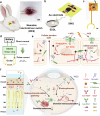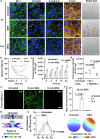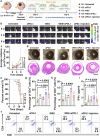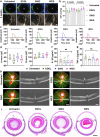Wearable electrodriven switch actively delivers macromolecular drugs to fundus in non-invasive and controllable manners
- PMID: 39747871
- PMCID: PMC11695998
- DOI: 10.1038/s41467-024-55336-1
Wearable electrodriven switch actively delivers macromolecular drugs to fundus in non-invasive and controllable manners
Abstract
Current treatments for fundus disorders, such as intravitreal injections, pose risks, including infection and retinal detachment, and are limited in their ability to deliver macromolecular drugs across the blood‒retinal barrier. Although non-invasive methods are safer, their delivery efficiency remains suboptimal (<5%). We have developed a wearable electrodriven switch (WES) that improves the non-invasive delivery of macromolecules to the fundus. The WES system, which integrates an electrodriven drug delivery lens with a square wave generator, leverages electrical stimulation to enhance drug penetration through the sclera-choroid-retina pathway. In our study, WES achieved a delivery efficiency of 14% for immunoglobulin G, comparable to that of intravitreal injection (16%). Moreover, WES-enhanced anti-VEGF administration resulted in an 86% inhibition of choroidal neovascularization, and anti-PDL1 delivery inhibited choroidal melanoma growth more effectively than intravenous injections, with no adverse effects on ocular health. These findings suggest that WES holds transformative potential for the non-invasive treatment of chronic fundus diseases.
© 2024. The Author(s).
Conflict of interest statement
Competing interests: The authors declare no competing interests.
Figures






Similar articles
-
Transscleral Iontophoresis for Noninvasive Ocular Drug Delivery of Macromolecules.J Ocul Pharmacol Ther. 2020 May;36(4):247-256. doi: 10.1089/jop.2019.0081. Epub 2020 Mar 5. J Ocul Pharmacol Ther. 2020. PMID: 32155098 Free PMC article.
-
Pirfenidone ameliorates the formation of choroidal neovascularization in mice.Mol Med Rep. 2020 May;21(5):2162-2170. doi: 10.3892/mmr.2020.11007. Epub 2020 Feb 27. Mol Med Rep. 2020. PMID: 32323767 Free PMC article.
-
Pharmacokinetics of HM-3 after intravitreal administration in mice.Curr Eye Res. 2014 Aug;39(8):837-44. doi: 10.3109/02713683.2014.883411. Epub 2014 Feb 21. Curr Eye Res. 2014. PMID: 24559456
-
Choroidal Osteoma with Choroidal Neovascular Membrane treated with Anti- vascular Endothelial Growth Factor: A Rare Case with Review of Literatures.Nepal J Ophthalmol. 2021 Jul;13(24):196-201. doi: 10.3126/nepjoph.v13i2.33218. Nepal J Ophthalmol. 2021. PMID: 35996784 Review.
-
Vascular endothelial growth factors in retinal and choroidal neovascular diseases.Ann Med. 2012 Feb;44(1):1-17. doi: 10.3109/07853890.2010.532150. Epub 2011 Feb 1. Ann Med. 2012. PMID: 21284527 Review.
Cited by
-
External stimuli-responsive drug delivery to the posterior segment of the eye.Drug Deliv. 2025 Dec;32(1):2476140. doi: 10.1080/10717544.2025.2476140. Epub 2025 Mar 24. Drug Deliv. 2025. PMID: 40126105 Free PMC article. Review.
-
A battery-free wireless sensor for encrypted signal transmission via Maxwell's displacement current.Microsyst Nanoeng. 2025 Jun 30;11(1):130. doi: 10.1038/s41378-025-00987-3. Microsyst Nanoeng. 2025. PMID: 40583062 Free PMC article.
References
-
- Fleckenstein, M. et al. Age-related macular degeneration. Nat. Rev. Dis. Primers.7, 31 (2021). - PubMed
-
- Wong, T. Y. et al. Diabetic retinopathy. Nat. Rev. Dis. Primers.2, 16012 (2016). - PubMed
-
- Falkenberg, K. D. et al. The metabolic engine of endothelial cells. Nat. Metab.1, 937–946 (2019). - PubMed
-
- Ferrara, N. Vascular endothelial growth factor and age-related macular degeneration: from basic science to therapy. Nat. Med.16, 1107–1111 (2010). - PubMed
-
- Tian, Y. et al. Reduction of choroidal neovascularization via cleavable VEGF antibodies conjugated to exosomes derived from regulatory T cells. Nat. Biomed. Eng.5, 968–982 (2021). - PubMed
Publication types
MeSH terms
Substances
Grants and funding
LinkOut - more resources
Full Text Sources
Research Materials

